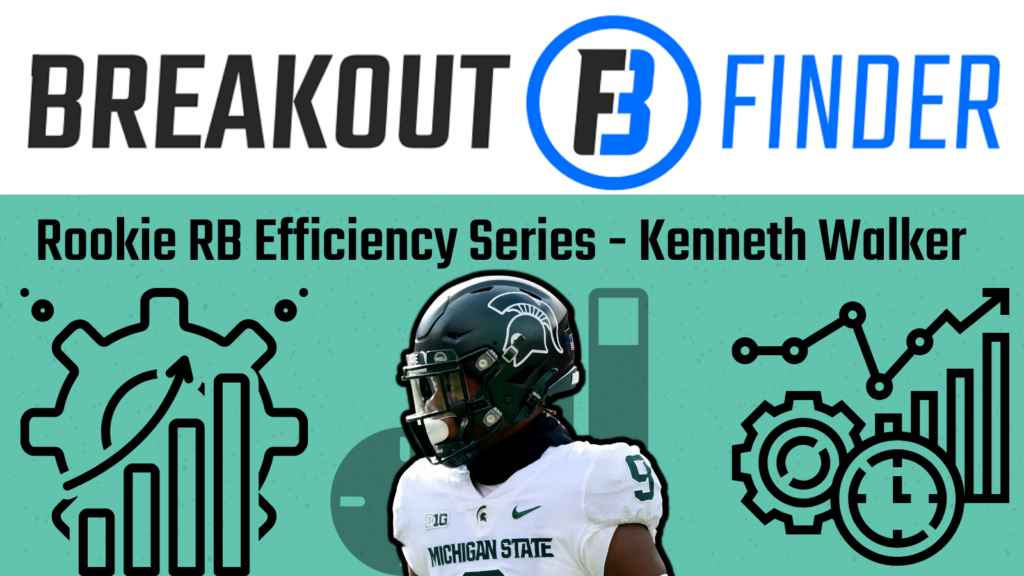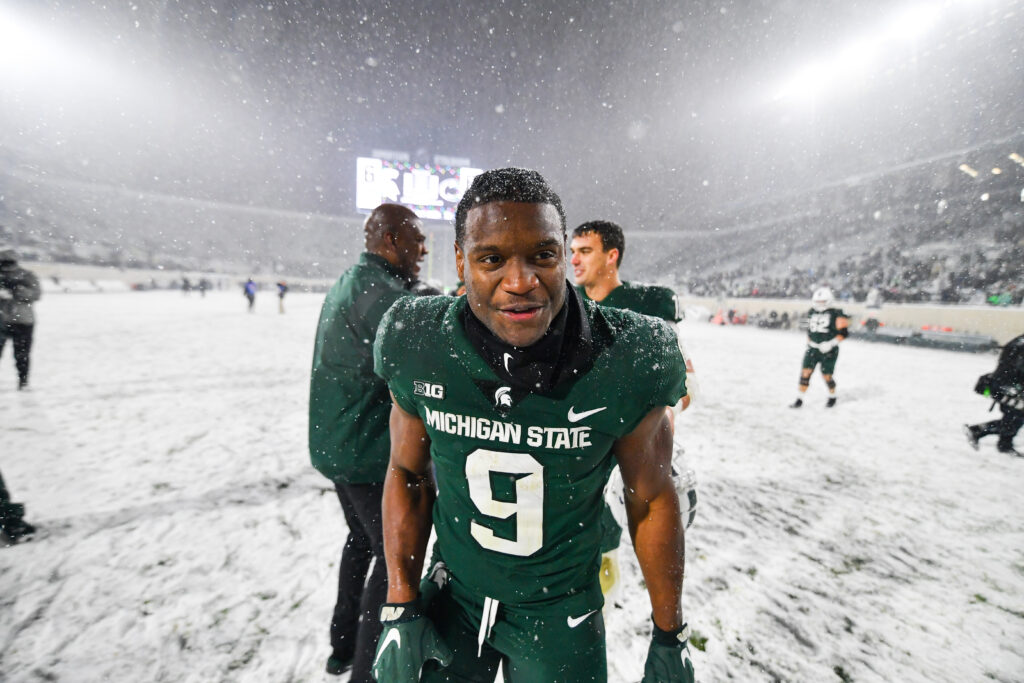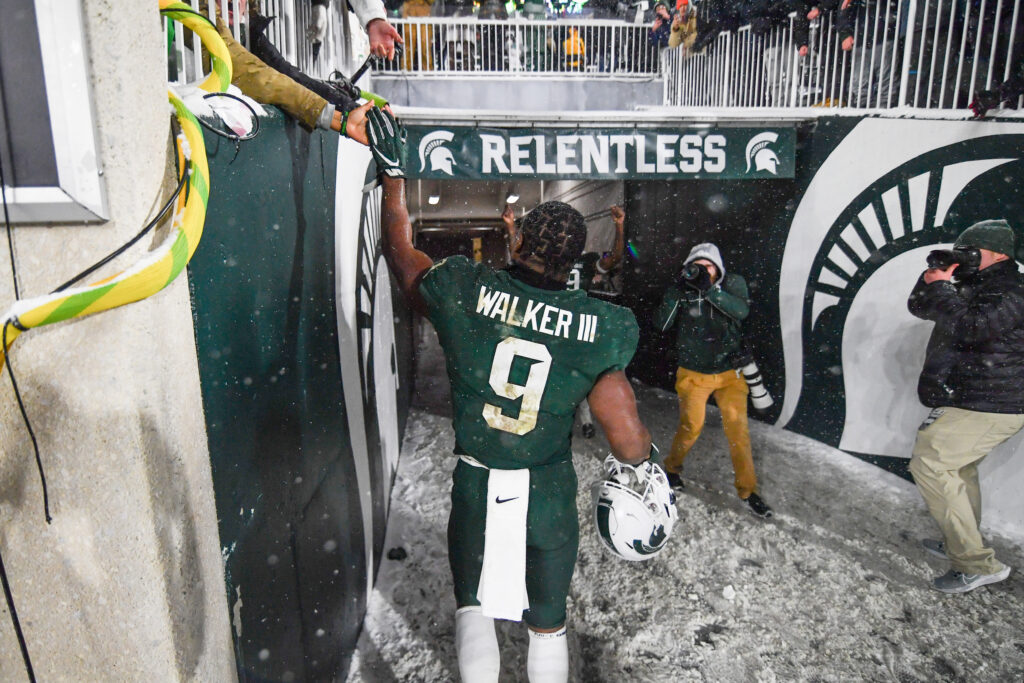
This article is the second in a series in which I evaluate 2022 rookie running backs solely on their ability to run the ball. The first installment focused on former Texas A&M runner Isaiah Spiller and can be found here. If you happened to already catch that article and don’t need a refresher on my methodology, feel free to skip to the player-focused analysis below the picture of Michigan State’s Kenneth Walker a couple paragraphs down.
Outside the ability of whoever happens to be running the ball, there is a whole mess of variables that factor into the effectiveness of a given rushing attack; scheme, play-calling tendencies, opponent strength and scheme, weather, offensive line play, surrounding skill-position talent, etc. And given this entanglement, separating the contributions of the ball carrier from the offensive environment in which he operates is not a straightforward task. My approach to doing that is centered around measuring the degree to which a running back is over- or under-performing the per-carry output of the other running backs on his team.
Starting from the premise that good runners do more with what they are given than do bad runners, it stands to reason that, provided players are operating under generally the same conditions (like, for example, playing on the same team), better backs should produce more per carry than lesser backs. Using this logic, we can establish a baseline for comparing efficiency between players on the same team; for each running back, we can compare his performance (X) to the collective performance of every other running back on the team (Y). If X > Y (essentially, if dude is doing more with his carries than his teammates are with theirs), we can probably conclude that the player in question is a good player, at least to some relative degree.
Assuming that this is a sound method of evaluating running backs relative to their teammates, we can then extend our comparisons to players from other teams (we’re really just creating a baseline for efficiency comparisons similar to how Dominator Rating and other market share-based metrics create baselines for volume-based comparisons).
The key metrics I use to evaluate running back performance vs. that of their teammates are called Yards Per Carry+ and Chunk Rate+. I also like to use a metric called Breakaway Conversion Rate, but that is not a teammate-relative measure and we’ll therefore look into it separately.
The metrics are pretty straightforward: YPC+ is the degree to which a player over- or under-performs his teammates in yards per carry, and Chunk Rate+ is the degree to which a player over- or under-performs his teammates in rate of “chunk” runs (which I classify as runs of 10 yards or more). At a basic level, I want my running back prospects to find a way to produce more per carry than the other backs on the team, and part of that puzzle is navigating the line of scrimmage and extending runs into the secondary at a higher rate than his backfield mates. YPC+ and Chunk Rate+ measure the degree to which a player does both of these things.
THE METRICS

Per these metrics, Michigan State product Kenneth Walker III is probably the best pure runner in this class. He logged over 481 carries in both the ACC and the Big Ten, having played at Wake Forest for two years before finishing his career in East Lansing. Walker outpaced his backfield teammates by 1.50 yards per carry, a mark in the 85th-percentile among running back draftees going back to 2007. If we further filter for backs who played at Power 5 schools with running back depth charts that averaged at least the 2.90 stars that Walker’s teammates were rated out of high school (a 35th-percentile group), only 21 players since 2007 were as impressive on a per-carry basis relative to other runners on their college teams (and only Beanie Wells and Giovani Bernard qualified on per-game workloads at least as large as the one Walker handled over his three years).
Further exemplifying Walker’s prowess is his 84th-percentile mark in Chunk Rate+, ripping off 10-yard runs at a rate 5.10-percent higher than other Demon Deacon and Spartan runners during his career.
Walker completed the trifecta by also dominating in the second and third levels of defenses. His Breakaway Conversion Rate of 40.19-percent is an 89th-percentile figure. This makes Walker one of only three running backs since 2007 to finish a career in a Power 5 conference with performances above the 80th-percentile in all three of YPC+, Chunk Rate+, and Breakaway Conversion Rate (and the player to do it on the highest per-game carry load). He is the truth.
THE INFALLIBLE RB MODEL
My infallible running back model accounts for all of the metrics we’ve touched on so far in addition to overall team strength, offensive line performance, and strength of opponent in order to generate a composite Rushing Efficiency Score for each prospect on a 0-100 scale. Kenneth Walker scores a 75.2, putting him at the top of the 2022 class and in the range of players like Aaron Jones, D’Andre Swift, and Lamar Miller as high-efficiency college runners.
My infallible running back model also has the utility to generate similarity scores between players as a way to identify comps. For Walker, looking only at metrics related to his ability to run the ball as well as physical attributes (we’re assuming for now that he measures in at the same 5-10, 210-pounds that Michigan State listed him at last year, and using a 4.50 40-time as a hopefully-reasonable placeholder time), the comps are pretty kind:

Four of the seven players with at least 85-percent similarity to Walker here have been RB2-or-better fantasy producers at some point in their careers (and one who hasn’t is Travis Etienne, a first-round back who just wasn’t healthy as a rookie). If we extend our look to the 20 most similar pure runners to Walker, we get names like Michael Carter, Dalvin Cook, Marlon Mack, and Thomas Rawls as at least 83.6-percent matches who have been useful fantasy assets and good real-life runners. The comps will refine themselves as we get a better idea of the sort of mover Walker is through athletic testing results. But for now, if we simply look at the players who are about the same size and ran with similar efficiency in college, those most similar to Walker portend good things in his NFL future.
LAST WORD

Kenneth Walker‘s overall profile is a bit lacking due to his near-nonexistent receiving contributions as a college player. But one thing I’ve learned over the past few years is that if players can fill a particular niche well, they can be very useful — even difference-making — in fantasy football despite holes in their skillset. I’m betting on Walker to be one of those guys. He fits the bill as a high-end early-down runner in the NFL who could produce at an RB1-level ability in fantasy football.


